Aseptic Technique Survey
Answer the following survey question as it relates to your institution, then click submit.
Slide 41
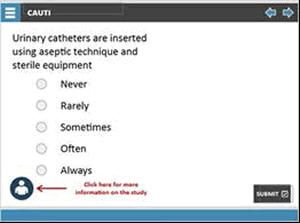
Urinary catheters are inserted using aseptic technique and sterile equipment
Options to select are: Never, Rarely, Sometimes, Often, or Always.
Slide 42
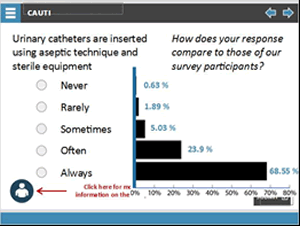
Urinary catheters are inserted using aseptic technique and sterile equipment
Options to select are: Never, Rarely, Sometimes, Often, or Always. How does your response compare to those of our survey participants?
Results in bar chart are: Never: 0.63%, Rarely: 1.89%, Sometimes: 5.05%, Often: 23.9%, and Always: 68.55%.
Slide 43
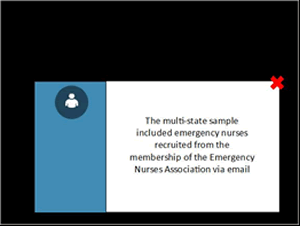
The multi-state sample included emergency nurses recruited from the membership of the Emergency Nurses Association via email.
Two-Person Survey
Answer the following survey question as it relates to your institution, then click submit.
Slide 44
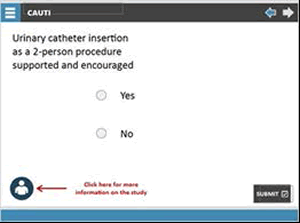
Urinary catheter insertions as a 2-person procedure supported and encouraged
(select yes or no)
Slide 45
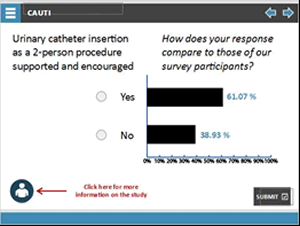
Urinary catheter insertions as a 2-person procedure supported and encouraged
(select yes or no).
How does your response compare to those of our survey participants?
Responses in bar chart are: Yes 61.07% and No 38.93%
Slide 46
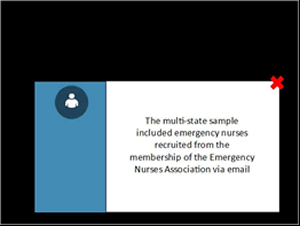
The multi-state sample included emergency nurses recruited from the membership of the Emergency Nurses Association via email.
This quote represents focus group member responses to questions about education and competency in CAUTI reduction and catheter insertion.
Slide 47

Theme: Education and competencies
"...just check it off"
Slide 48
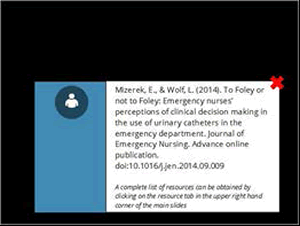
Mizerek E, & Wolf L. (2014) To Foley or not to Foley: Emergency nurses' perceptions of clinical decision making in the use of urinary catheters in the emergency department. Journal of Emergency Nursing. Advance online publication. 2014.
A complete list of resources can be obtained by clicking on the resource tab in the upper right hand corner of the main slides.
Training and Observation
Sterile technique in urinary catheter placement is part of pre-licensure nursing education. It is not a competency that is periodically reevaluated in every institution. Traditionally, competencies selected for demonstration have been those considered low-volume/high-risk: skills either not exercised frequently, which may decline due to lack of practice, or those associated with a higher risk of complications or difficulty. Sterile technique in urinary catheter placement has been regarded as neither. It is done frequently and is not considered high risk. However, because of the likelihood of infection, it might be time to consider it a high-risk procedure, in which providers would have to periodically demonstrate their competency, rather than something done as a quick annual check off without being evaluated in a clinical setting.
It was stated earlier that CAUTIs represent about 35 % of nosocomial infections. Why is there such a high rate of infection? In an unpublished study (Manojlovich, 2013), only 70.5 % of nurses surveyed reported using sterile technique “always.” Also, observations revealed breaks in sterility even by those individuals who considered their technique sterile and knew they were being monitored. Two-person catheter insertion promotes the practice of sterile technique, as the second person can assist with positioning and observe for breaks in sterility.
Slide 49
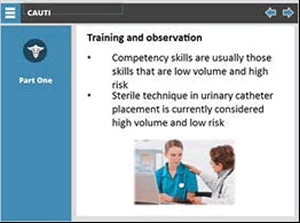
Training and observation
- Competency skills are usually those skills that are low volume and high risk
- Sterile technique in urinary catheter placement is currently considered high volume and low risk
Slide 50

- Only 70.5 % of nurses in an observational study always used sterile technique.
- Breaks in sterile technique observed even in those who consdered their technique sterile.
Slide 51
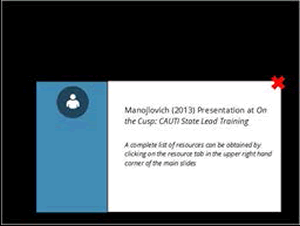
Manojlovich (2013) Presentation at On the Cusp: CAUTI State Lead Training
A complete list of resources can be obtained by clicking on the resource tab in the upper right hand corner of the main slides.
Slide 52
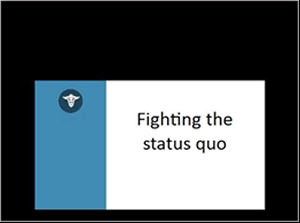
Fighting the status quo
This quote represents a response by a focus group member regarding barriers to CAUTI reduction.
Slide 53

Theme: Barriers
"It's how we've always done it."
Slide 54
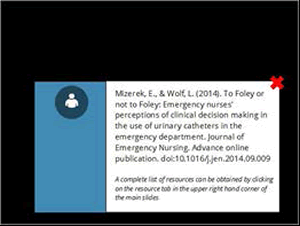
Mizerek E, & Wolf L. (2014) To Foley or not to Foley: Emergency nurses' perceptions of clinical decision making in the use of urinary catheters in the emergency department. Journal of Emergency Nursing. Advance online publication. 2014.
A complete list of resources can be obtained by clicking on the resource tab in the upper right hand corner of the main slides.
Status Quo
In addition to training and observation issues, another obstacle is complacency regarding the status quo. Health care practitioners as a group can be highly influenced by social norms, and the experiences, attitudes, and biases of participants can affect the decision-making process.
“This is what we have always done” becomes the battle cry of those individuals resistant to change. The overall culture of an emergency department, including the tendency to maintain the status quo, can challenge good clinical decision-making. However, if the culture embraces change and evidence-based practice, the outcome can be good clinical decision-making.
Slide 55
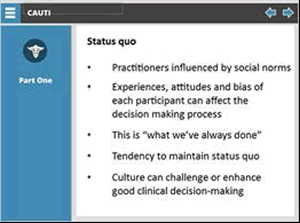
Status quo
- Practitioners influenced by social norms.
- Experiences, attitudes, and bias of each participant can affect the decision making process.
- This is "what we've always done."
- Tendency to maintain status quo.
- Culture can challenge or enhance good clinical decision making.
Slide 56
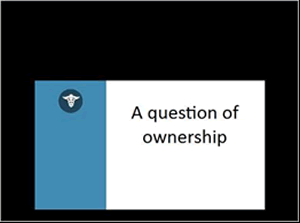
A question of ownership
Ownership
A question of ownership can be an obstacle in the move from recommendations to practice change.
Emergency nurses in this sample indicated that CAUTI is not an issue that “belongs” to the emergency department. They reported that things were started in the emergency department, not undone: patients were readied or “packaged” for inpatient units, and the indwelling catheter was often considered part of the package.
Because of this perception, emergency nurses in this sample did not feel as much ownership of the possible adverse outcome, although they reported that they held ownership of the decision to place the catheter initially.
Since an infection won’t develop until the patient has left the ED, the emergency nurse does not see the patient outcome associated with the decision to catheterize.
So whose problem is urinary catheterization anyway? Emergency nurses? Inpatient nurses? Providers? Assumptions around catheter use and the issues they create become the problem of the institution, not of individual nurses or patients. Accepting shared responsibility and individual accountability is a big step toward addressing the problem.
Slide 57
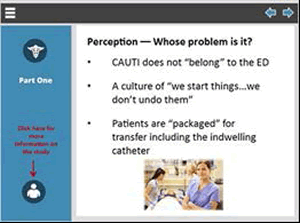
Perception -- whose problem is it?
- CAUTI does not "belong" to the ED.
- A culture of "we start things...we don't undo them."
- Patients are "packaged" for transfer including the indwelling catheter.
Slide 58
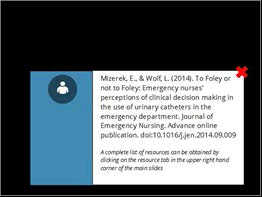
Mizerek E, & Wolf L. (2014) To Foley or not to Foley: Emergency nurses' perceptions of clinical decision making in the use of urinary catheters in the emergency department. Journal of Emergency Nursing. Advance online publication. 2014.
A complete list of resources can be obtained by clicking on the resource tab in the upper right hand corner of the main slides.
Slide 59
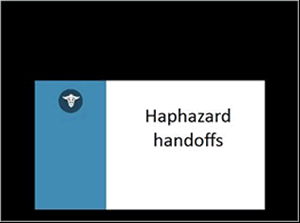
Haphazard handoffs
Cryptic Handoffs
In the ED, verbal handoffs, whether between nurses or between nurses and other clinicians, have been characterized as “partial,” “cryptic,” and “remarkably haphazard.”
Uninformed assumptions of both the emergency nurse and the inpatient nurse contribute to a chaotic handoff.
Slide 60
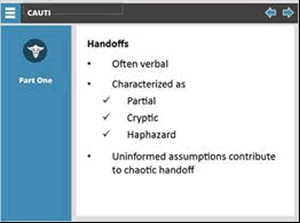
Handoffs
- Often verbal.
- Characterized as:
- Partial
- Cryptic
- Haphazard.
Uninformed assumptions contribute to chaotic handoff.
Slide 61
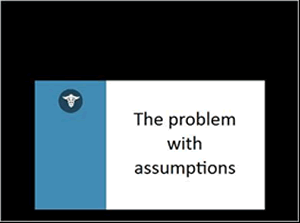
The problem with assumptions
Problematic Expectations
Because it is customary for many patients to come from the ED with an indwelling catheter in place, the inpatient nurse might come to expect it. If the emergency nurse were to start sending patients without indwelling catheters, it could be viewed as an oversight. Such a change in practice, even though it might be best for the patient, could cause a perceived or actual increase in workload for the inpatient nurse. In some cases, this might intensify a preexisting culture of conflict between the two nursing staffs.
Slide 62
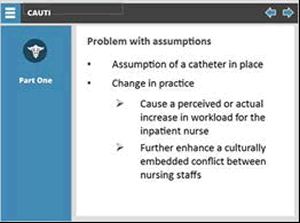
Problem with assumptions
- Assumption of a catheter in place.
- Change in practice:
- Cause a perceived or actual increase in workload for the inpatient nurse.
- Further enhance a culturally embedded conflict between nursing staffs.
Assumptions Questioned
If a patient comes to the unit with a catheter in place, the inpatient nurse might assume that it was an appropriate placement and that the emergency nurse would have removed it if it were no longer needed. By the same token, the emergency nurse might assume that there is a continued need for a catheter, and that this need would be reevaluated on the floor. In reality, it may be several hours before the inpatient nurse would evaluate the need to remove the catheter. The inpatient and emergency nurses need to communicate clearly regarding the criteria for placement of an indwelling urinary catheter in addition to indications for its continued use.
Slide 63
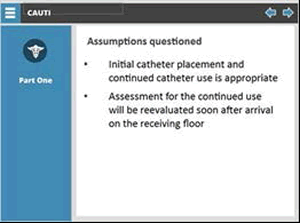
Assumptions questioned
- Initial catheter placement and continued catheter use is appropriate.
- Assessment for the continued use will be reevaluated soon after arrival on the receiving floor.
Slide 64
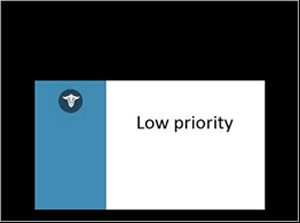
Low priority
Quality Improvements
Click on each quality improvement program for CAUTI prevention that are in place in your ED, then click submit.
Slide 65

What are the quality improvement programs for CAUTI prevention in your ED? Click on all that apply and then submit.
Selections are:
- Alerts to evaluate the need to retain the urinary catheter for admission
- Chart review for presence of physician’s order for placement
- Chart review for presence of documentation of appropriate indication for catheter placement
- Prompt to discuss indication for catheter placement in report to inpatient RN
- Guidelines for algorithms for appropriate perioperative catheter management, multidisciplinary urinary catheter “rounds"
- Protocols for nurse-directed removal of unnecessary catheters
- STOP orders for urinary catheters
- None
Finally, CAUTI reduction can be relegated as low priority. There are still health care facilities that have no CAUTI reduction initiatives or guidelines. With the onset of clinical manifestations of CAUTI beginning after the patient has left the ED, the priority can become even lower.
Slide 66

What are the quality improvement programs for CAUTI prevention in your ED? Click on all that apply and then submit.
Results are:
Alerts to evaluate the need to retain the urinary catheter for admission 40.88%, Chart review for presence of physician’s order for placement 52.20%, Chart review for presence of documentation of appropriate indication for catheter placement, 58.49%, Prompt to discuss indication for catheter placement in report to inpatient RN 27.04%, Guidelines for algorithms for appropriate perioperative catheter management 26.42%, Multidisciplinary urinary catheter “rounds” 0.0%, Protocols for nurse-directed removal of unnecessary catheters 0.0 %, STOP orders for urinary catheters 0.0 %, and None 20.33%.
Slide 67

The multi-state sample included emergency nurses recruited from the membership of the Emergency Nurses Association via email.
Recommendations
CAUTI reduction initiatives include—
- Chart review
- Is an order entered for the catheter?
- Is there an appropriate indication for insertion?
- Is there documentation of continued need upon admission?
- Perioperative algorithm
- Is there an algorithm in use for perioperative placement?
- Is the staff aware of and educated about the algorithm?
- Is it used consistently?
- Nurse-directed removal
- Is there a protocol for the nurse to evaluate ongoing need and remove the catheter if the criteria are met?
- Is the protocol followed consistently?
- Catheter “rounds” and STOP orders
- These are more relevant in the inpatient environment, but is there a protocol in place that ensures every patient in the ED with an indwelling urinary catheter is evaluated for the appropriateness of the initial placement and whether there is an ongoing need?
Slide 68

CAUTI reduction initiatives
- Chart review
- Perioperative algorithm
- Nurse-directed removal
- Catheter rounds
- STOP orders
Slide 69

Min S. (2014) Accuracy of electronic surveillance of catheter-associated urinary tract infection at an academic medical center. Infection Control and Hospital Epidemiology. 2014;35(6):685-91.
A complete list of resources can be obtained by clicking on the resource tab in the upper right hand corner of the main slides.



